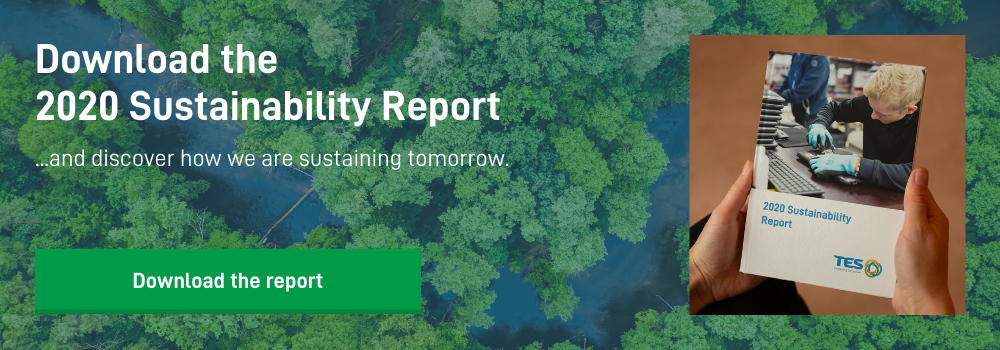The circular economy for ICT equipment has the potential of reducing the 50 million tonnes of e-waste produced each year. Here’s how.
ICT equipment and the e-waste it can eventually become, is a problem. In the 2019 ‘A New Circular Vision for Electronics’ report by the World Economic Forum (WEF), it was found that on average, six kilograms of electronic waste was generated per person globally. This is equivalent to 125,000 jumbo jets.
As stakeholders in our global economy, we need to ensure we extend the life of products and materials, all doing our part to drive sustainable business continuity. With more than 100 billion tons of the earth’s resources flowing into the global economy each year, the circular economy for ICT equipment is critical to limit our impact, reduce our dependence on virgin resources and ensure those resources are reused.
Defining the circular economy
A circular economy represents a more environmentally-friendly and equitable alternative to the traditional linear economy. In it, resources are used for the longest time and when discarded, eligible materials are reintroduced into new products. This type of economy is naturally regenerative.
In the circular economy, materials undergo the following process:
-
-
-
- Materials are extracted or created, then manufactured into products.
- These products go to market.
- After sale, they’re used to the full extent of their lifespan.
-
-
A circular economy represents a more environmentally-friendly and equitable alternative to the traditional linear economy. In it, resources are used for the longest time and when discarded, eligible materials are reintroduced into new products. This type of economy is naturally regenerative.
In the circular economy, materials undergo the following process:
-
-
-
- Materials are extracted or created, then manufactured into products.
- These products go to market.
- After sale, they’re used to the full extent of their lifespan.
- Those products are then reused, repaired (if applicable) or recycled.
- The recycling sector takes the products, turns them back into raw materials which then feed back into forward manufacturing.
-
-
In a circular economy, organizations large and small recognize the need for efficiency, working to three key principles:
-
-
-
- The regeneration of natural resources and systems.
- Extending the value and use of products by increasing their lifespans.
- Designing out both waste and pollution.
-
-
This isn’t about limiting the negative impacts of the linear economic model, but rather demanding systemic change. So what does it look like?
Extraction & design
Ensure designs allow for longer use and the recovery of materials. They also need to have minimal use of virgin materials.
Fairphone is doing just this - offering products allowing consumers to upgrade or replace aspects of their smartphone themselves through modular design. A consumer might for example, upgrade or replace their camera, rather than the whole handset.
Production
Manufacture products with recycled materials. Work to reduce waste in the manufacturing process.
The World Economic Forum reported recently on 6 tech giants who are working to do just that. Such as Apple’s commitment to a carbon neutral supply chain and product line by 2030 through closed loop thinking, and innovations like their now 100% recycled aluminium enclosures, this is a change already happening and gaining momentum.
Use
Optimize use through the ability to repair rather than replace. Promote recycling when the asset reaches the end of use.
Collection & recycling
Ensure effective collection services are in place.
Similarly, a sustainable circular economy also needs to consider investing in recycling infrastructure and promoting and developing the market for recycled materials.
The circular economy may seem like just preventing waste from entering landfill, but it’s more than that. It’s all about closing the loop, conserving natural resources and making sure the economy we live in is more sustainable for all.
The circular economy for ICT equipment
Driving the circular economy requires systemic change, mainly aimed at how we consume and manage our resources.
Limit our consumption of raw materials
We consume too much. Our rate of resource consumption doesn’t even mirror our rate of population growth - it’s twice the amount. In the ‘Global Material Flows and Resource Productivity’ report by the UNEP International Resource Panel, it was discovered that ‘annual global extraction of materials [grew] from 22 billion tonnes (1970) to 70 billion tonnes (2010).’ This is an exponential increase.
For ICT equipment, the focus has to be on reusing materials that have previously been extracted. There’s already the potential for massive recycling programs, but it’s up to key stakeholders to begin enacting them.
Be smarter with materials
A key issue for many types of ICT equipment (and electronics) is they’re not built to be repaired. Businesses have to keep pace with technology by investing in new technology to remain competitive. The adverse effect of this is that it causes drastic problems with overconsumption of raw materials. This is a vicious cycle; as tech use increases within society, there is more need for raw material use to support that tech.
An easy first step towards circularity is to choose to design more sustainable ICT products. If we’re not in a position to design, we can influence markets through our purchases to bring about a more sustainable product.
ICT products can be easily designed to make more repairs possible, opening up new markets for spare and replacement IT parts - rather than just buying new models when previous ones become broken or enter that state of their lifecycle known as ‘planned obsolescence’.
France’s repairability index launched in early 2021 and aims to combat planned obsolescence by channelling that consumer influence, with other European countries expected to also follow. The index sets out to highlight how repairable a product is, in turn encouraging consumers to select manufacturers based on that index.
Systemic change
The issue for many is that consumption drives growth, and who doesn’t like growth? However, growth cannot be infinite on a finite planet using traditional methods. We have to disrupt those methods and drive systemic change within our global infrastructure. It means that consumption needs to be disconnected from economic prosperity.
This kind of change has to come about through a top-down, bottom-up approach (consumers can only influence so much), with key stakeholders placed on all rungs of the ladder.
Already, policies and practices that are working to bring about a more sustainable economy are in place, such as the political call for a post-COVID green new deal, individual customer trends and businesses who proudly call themselves ‘zero waste’. ICT manufacturers and digitally-driven companies are starting to lead the way.
From a socio-economic perspective, there’s much that can be done. For example, governments can place taxes on products that only use virgin materials. Incentives like this are small, but when combined, make a big impact. So far, the impact has been negative.
The impact of ICT e-waste
Not only is there an economic case for a circular economy for ICT, there’s also an environmental one. We’re currently faced with the problems being caused by the climate crisis - a transition towards the circular economy would help reduce greenhouse gas emissions and help to protect natural environments.
To understand why this change is needed, you need to understand the following statistics regarding the impact of e-waste:
-
-
-
- In 2016, 44.7 million metric tons of e-waste was generated globally and in 2021, the annual e-waste total is expected to rise to 52 million metric tonnes.
- It’s expected that 14% of our annual carbon emissions will be attributable to electronics production by 2040.
- According to the UN’s Global E-waste Monitor Report, at least $10bn worth of precious metals, such as gold and platinum, end up in landfills.
- E-waste generation isn't globally consistent. In 2019, the per capita production of e-waste in Northern Europe was roughly 23kg. In Africa, this was roughly 3kg.
- Recycled metals can range from two to ten times more energy-efficient than those smelted from virgin ore.
- In 2017, the value of raw materials in e-waste was worth $US62.5 billion annually.
-
-
It's clear we need to take action to minimize our impact on the planet. Incorporating not only sustainability, but also e-waste compliance across our entire infrastructures is the very definition of ‘good’ business.
Electronic waste recycling is one part of the circular economy puzzle. To explore TES’s commitments, initiatives, achievements and for information regarding the transition towards a circular economy, download our report.
The TES Sustainability Report
Inside our report, you can explore real-life sustainability initiatives that can be harnessed for electronic waste, such as the recycling of lithium-ion batteries. Here at TES, we’re committed to extending the use-life of electronics, promoting the circular economy that’s needed globally.
Download our report to find out more about our impact and what a slice of the circular economy looks like in practice. Get your copy below.
About the author
Petra Dlabacova, Senior Business Development Manager
 Petra has a particular interest in the sustainability and circular economy, and was involved in a 12 month project on “Current commercial hardware recycling footprint and its future re-use and disposal towards a more sustainable environment”.
Petra has a particular interest in the sustainability and circular economy, and was involved in a 12 month project on “Current commercial hardware recycling footprint and its future re-use and disposal towards a more sustainable environment”.






